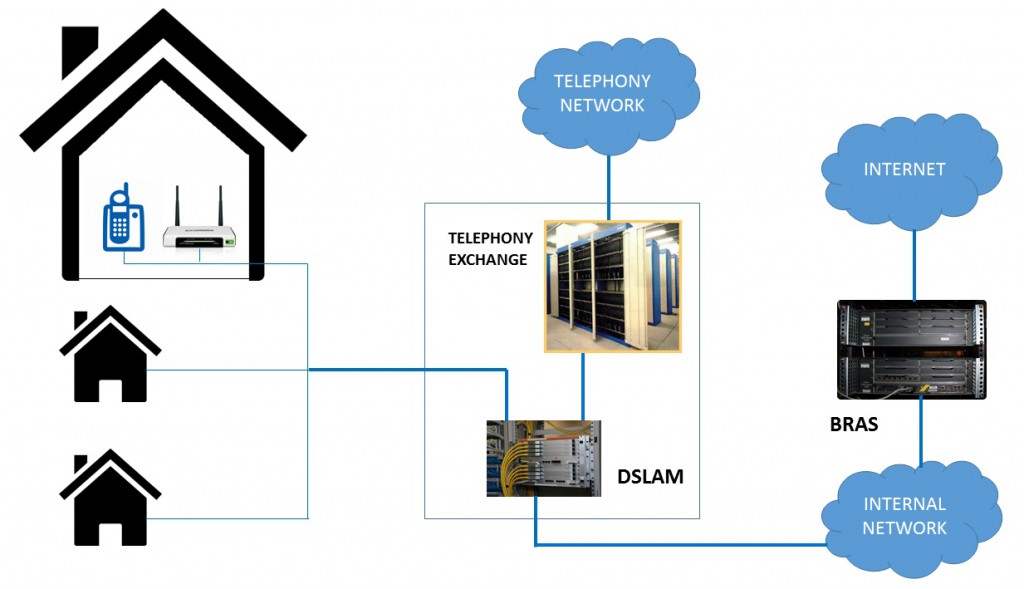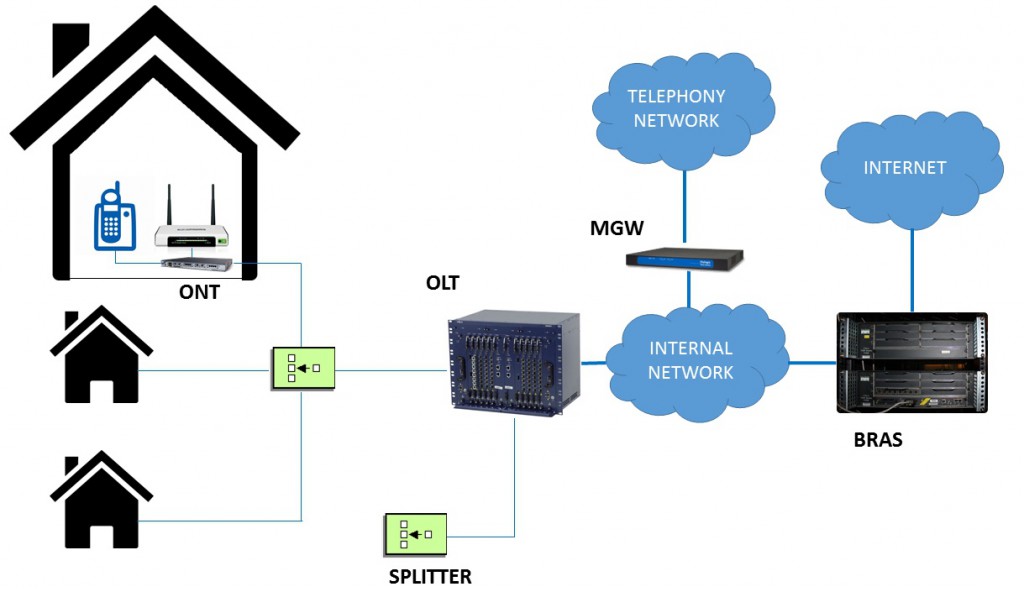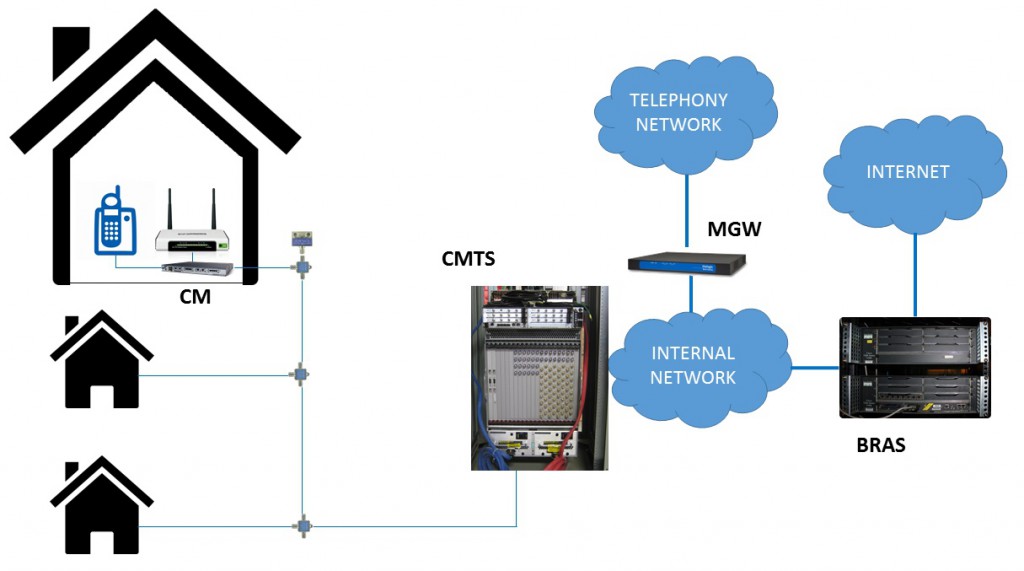Fixed networks offer high-capacity connections but a reduced or no mobility to their subscribers. Access to fixed networks is provided always in the same building or area. Connection use to be a cable limiting mobility to the length of this cable. Thanks to the high-capacity and security of last Wifi standards every time they are more used for connecting to fixed networks instead of cables. In this case subscribers can move and connect anyplace inside the area covered by Wifi access points. Even in this case it cannot be considered mobile networks at all because this air connection is in charge of the customer.
| CPE | BRAS | ADSL | Wifi |
| Router | DSLAM | FTTH | Wimax |
| Cable |
CPE stands for “Customer Premise Equipment”. It is the end of fixed network and start of end customer network. In case of ADSL connection it is the router connected to the line. In case of cable connection CPE receives the coaxial cable from fixed network and its output is an ethernet cable connected to our router. FTTH networks are similar to cable ones but using a fiber optic cable. Our router is connected to fiber optic CPE as cable networks. Normally operators use to provide some support to private network but, theoretically, CPE is the end of operator responsibility.
Router
Fixed network CPE provide connection for an only equipment but end customer use to have several equipments to be connected. Router creates an internal network where end customer could connect a big number of computers and equipment. Using NAT (Network Address Translation) techniques al these customer equipments can connect to internet using the same IP address. Router doesn’t connect directly to internet in the CPE but in BRAS. Using PPP (Point to Point Protocol) protocol router establish a connection to BRAS through ADSL, Cable or FTTH network. Effect is all internet connections are going out from BRAS. Additionally router has configured login and password used for PPP connection authentication. As we have mentioned operator responsibility ends on CPE but operators use to take care of router as it is a really important element in customer network. Routers use to have a Wifi connection to facilitate internal network connections.
BRAS
BRAS stands for “Broadband Remote Access Server”. BRAS received PPP connections from customer router through ADSL, Cable or FTTH network. BRAS authenticate login and password and assign IP address to be used in internet. Range of IP address used for customer internet connections is configured in BRAS.
ADSL
ADSL stands for “Asymmetric Digital Subscriber Line”. ADSL technology provide internet connection using classical telephony line. Maximum capacity is 20 millions of bits per second (MBit/S) but only in some specific cases. Maximum speed depends on the length of the cable from the exchange to our house. More distance less speed. Even in big cities with small distance from the exchange it is difficult more than 10 MBit/S speed. In residential areas it is normal 3 MBit/S or less. ADSL connection is point to point and only one CPE is possible. Normally ADSL CPE use to be integrated in special ADSL routers. Sometimes it is needed to install filters (provided by operator) to avoid other equipments connected like our telephones could give some problems. The operator equipment in the other side of the cable is called DSLAM.
DSLAM
DSLAM stands for “Digital Subscriber Line Access Multiplexer”. DSLAM is the equipment “in the other side” of the cable. When we contract an ADSL internet connection our telephone line is connected through the DSLAM of our internet provider. Through our telephone line our ADSL router connect with operator DSLAM without interference telephony service. This connection is point to point, only one ADSL router could be connected in each telephone line. Each DSLAM equipment support the connection of several telephone lines but it manages each one independently. Connection between ADSL router and DSLAM is the slowest part of internet connection and normally the one limiting it. DSLAM is in charge as well of limiting speed according to our contract. Once in DSLAM telephone line continues to telephony exchange and data connection continues to operator network in a high-capacity link. As we have mentioned distance between ADSL router and DSLAM has a big impact in maximum speed. Operators try to locate DSLAM as closed as possible to their customer in order to provide a higher connection speed.

FTTH
FTTH stands for Fiber To The Home. Normal technology used is GPON (Gigabit-capable Passive Optical Network). This technology use optical fibers to communicate our home with the network. The main advantage of optical fibers is high-capacity even when our home is far from the exchange. In GPON technology fibers from several homes are grouped in a single fiber. Grouping is done several times in order to reduce the number of fibers arriving to the exchange. These grouping equipments or concentrators are passive and they don’t need power supply and it can be located anyplace in the street. Of course the capacity of the fiber arriving to the exchange is the sum of all the connections concentrated in this fiber. Normal speed at home side use to be 100 MBit/S but, in the future, it is considered 1 GBit/S.
Optical fiber termination in our home or CPE is called ONT (Optical Network Termination). Our router is connected to this ONT using a copper ethernet cable. It is recommended to have the CPE or ONT fixed to the wall as fiber optic could break if ONT is moving. For router this problem doesn’t exist as copper cable is more robust. As indicated in BRAS point our router establish a PPP connection with BRAS through FTTH network. ONTs use to have a VoIP (Voice over IP) client offering a legacy telephony interface. In this interface we can connect our legacy fixed phones or a fax, but the connection to the exchange is done using VoIP technology over the same fiber. The impact in capacity is minimum as telephony service only needs 300 KBit/S.

Above picture shows FTTH network architecture. Fibers are grouped by passive elements (no power supply needed) called “Splitters” until OLT (Optical Line Termination). From this point it is a high-capacity networks similar to Internet but private to the operator. This network is invisible for the end-user and it is considered the connection to internet start in BRAS element. MGW (Media Gateway) receives VoIP connections from ONT and adapt them to legacy telephony network. Nowadays all exchanges use VoIP technology and no adaptation is needed but MGW element remains.
Cable
Internet providers using Cable technology are the ones providing Cable TV with CATV technology. CATV technology is similar to TV distribution inside a building. CMTS (Cable Modem Termination System) send a high power signal through coaxial cable where all subscribers are connected. Every subscriber extract a minimum power for not affecting the signal travelling through the cable. All subscribers listen to all channels but only take the one for each one. DOCSIS technology (Data Over Cable Service Interface Specification) was developed over CATV. DOCSIS use the channels not use for TV for data communication. Each subscriber use one channel. Additionally the direction from the modem to CMTS is established in the same channel.

DOCSIS technology is an intermediate one between ADSL and FTTH. Fiber optics are used to distribute internet connections but the cable arriving to our home is a coaxial cable. Coaxial cable have more capacity than ADSL and it was used to provide a higher capacity connection when there was no FTTH. Last Cable technology is named DOCSIS 3.1 and provide 10 GBit/S capacity comparable with FTTH but FTTH can provide the same speed to longer distances like rural areas where DOCSIS or ADSL are not valid. Similar to FTTH coaxial cable is terminated in CPE where router is connected with an ethernet cable.
Wifi
Wifi is a wireless technology providing mobility to fixed networks in an area of tens of meters from the antenna. Some Wifi antennas could be deployed to cover big areas but every equipment is connected to one of them. If changing from one antenna to other one the connection is drop and it has to be reestablished. Wifi is a set of standards with the name 802.11. Slowest one is 802.11b providing up to 10 MBit/S. 802.11g provide up to 54 MBit/S and the fastest one, 802.11ac provide up to 1.3 GBit/S. IEEE organization is the one in charge to standardize this technology and it has standardized from 802.11a to 802.11af but the most used are the ones mentioned before. There are two bands used by Wifi connections: 2.4 GHz and 5 GHz. Both are non regulated bands and they can be used by anyone without any control. Because of this connection quality cannot be assured but normally there is no problem indoor. For outdoor coverage the situation is different and Wifi connection are not really reliable. Mobile operators are considering LTE-U or LTE unlicensed technology which uses the same bands. This technology could be a competitor of Wifi in some specific cases.
Wimax
Wimax stands for “Worldwide Interoperability for Microwave Access”. This technology is standardized by IEEE organization as well with 802.16 identifier. Different to Wifi technology Wimax is though for public access providing internet connection in a 60 Km area around the antenna. Wimax normally use 2.3 GHz or 3.5 GHz bands. These bands are licensed ones and operators need a license to using it. Latest 802.16 standard (802.16e) provide some kind of mobility. Wimax is used by operators to provide internet connections in areas where it is difficult to deploy a cable. Equipment in customer premises use to be antenna in building roof receiving Wimax signal and normal cabling is used to distribute internet connection internally in the building. Connection capacity use to be 20 MBit/S in a 6 Km area around the operator antenna. This technology has not fulfilled expected success as it is used only in specific cases when other technologies are not available.
